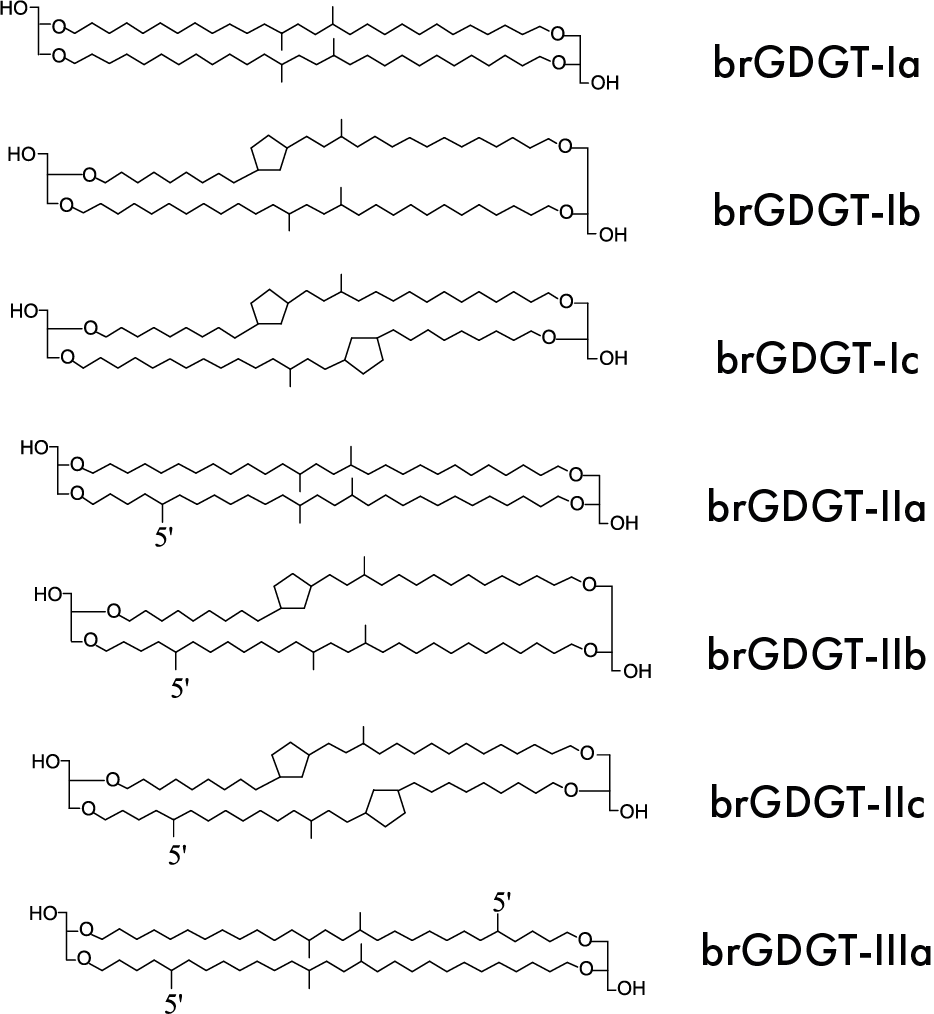Accurately quantifying sea surface temperature (SST) during Earth’s history is critical for understanding a range of key climate processes, such as climate sensitivity and polar amplification. The distribution of molecular fossils (‘biomarkers’) are widely used as paleothermometers, because they derive from a specific biological source organism and can be preserved in the sedimentary record for millions of years.
Reconstructing ocean temperature
Fig.1. IsoGDGTs typically found in marine sediments.
Isoprenoidal glycerol dialkyl glycerol tetraethers (GDGTs) are membrane-spanning lipids. These are thought to be mainly derived from marine Thaumarchaeota, ammonium-oxidizing archaea that inhabit both the surface ocean and mesopelagic zone (< 300m).
Experimental and field-based studies indicate that isoGDGTs with fewer rings are produced in cold waters whereas those with more rings are produced in warm waters. A simple index, based upon the number of cyclopetane rings in isoGDGTs (TEX86), can be used to estimate the temperature of the ocean in the past (e.g. Inglis et al., 2015; Hollis et al., 2019)
Fig. 2. Typical distribution of isoGDGTs in “cold” and “warm” settings.
Reconstructing TERRESTRIAL temperature
Fig.3. 5-methylated brGDGTs typically found in terrestrial sediments.
Branched GDGTs are membrane-spanning lipids derived from bacteria (likely acidobacteria). These compounds were originally identified in peat; however, they are also abundant in soil and lake environments.
The degree of methylation in brGDGTs is significantly correlated to mean annual air temperatures. This is reflected in the MBT5me index and has been used to reconstruct terrestrial temperatures in ancient peat deposits (e.g. Inglis et al., 2019; Naafs et al., 2018). Branched GDGTs can also be transported to the marine realm via rivers; as such, this approach can also be applied to continental shelf sediments (e.g. Inglis et al., 2017).
Key publications
Inglis, G.N., Farnsworth, A., Carmichael, M., Collinson, M.E., Naafs, B.D.A., Lunt, D.J., Valdes, P.J., and Pancost, R.D (2019) Terrestrial environmental change during the PETM: a cautionary tale. Global and Planetary Change. 181. 102991
Farnsworth, A., Lunt, D.J., O’Brien, C., Foster, G.L., Inglis, G.N., Markwick, P., Pancost, R.D and Robinson, S.A. Climate sensitivity on geological timescales controlled by nonlinear feedbacks and ocean circulation. Geophysical Research Letters. Early View.
Inglis, G.N., Collinson, M.E., Riegel, W., Wilde, V., Farnsworth, A., Lunt, D., Valdes, P., Robson, B., Scott, A., Lenz, O., Naafs, B.D.A and Pancost, R.D (2017) Early Paleogene continental temperature change in western-central Europe. Earth and Planetary Science Letters. 460. 86-96
Hollis, C. J. et al (2019) The DeepMIP contribution to PMIP4: methodologies for selection, compilation and analysis of latest Paleocene and early Eocene climate proxy data, incorporating version 0.1 of the DeepMIP database. Geoscientific Model Development. 12. 3149-3206
Naafs, B.D.A., Rohrssen, M, Inglis, G.N., Lahteenoja., Feakins, S., Collinson, M.E., Kennedy, E.M., Singh, P.K., Singh, M.P., Lunt, D.J. and Pancost, R.D. High temperatures in the terrestrial mid-latitudes during the early Paleogene. Nature Geoscience. 11. 766771
Inglis, G.N., Farnsworth, A., Lunt, D., Foster, G.L., Hollis, C.J., Pagani, M., Jardine, P., Pearson, P.N., Markwick, P., Galsworthy, A., Raynham, A., Taylor, K.W.R and Pancost, R. D (2015) Descent towards the Icehouse: Eocene sea surface cooling inferred from GDGT distributions. Paleoceanography. 30. 1000-1020.



